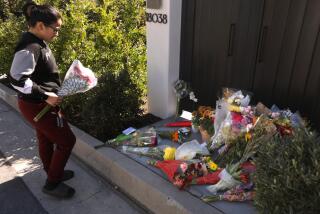Ex-Deputy Chief Focus of Money-Laundering Probe
A 40-year veteran of the Los Angeles Police Department who until recently was one of its highest-ranking officials is under investigation for real estate transactions that authorities believe may have laundered money from a multimillion-dollar cocaine ring headed by his son.
Deputy Chief Maurice Moore, 66, retired in January as investigators from the LAPD and FBI probed his financial ties to his son, Kevin Moore, a convicted cocaine trafficker.
Maurice Moore, through his attorney, denied any wrongdoing. He declined to comment further on the advice of his lawyer, who also declined to discuss the matter in detail.
LAPD officials have been looking into allegations against Moore for well over a year, and at least some members of the Police Commission have been briefed about it.
Moore, a longtime friend and special assistant to Police Chief Bernard C. Parks, was allowed to continue in his job while the investigation was underway. Under Parks, LAPD officers accused of crimes or serious misconduct often have been ordered to remain at home during working hours until the cases against them have been resolved.
Parks declined to discuss specifics of the Moore case on Friday, but said the LAPD was continuing to probe the allegations against him. “At the conclusion,” Parks said, “we will determine if there’s anything he is culpable of.”
In the meantime, Moore, long regarded as a friendly, approachable LAPD supervisor, has retired from the LAPD, officially winding up his service on Jan. 26. A message in Parks’ monthly newsletter said Moore’s long career was “distinguished by his remarkable commitment to continuous public service,” adding that the deputy chief had gone for more than 30 years without taking a single day off due to illness.
According to public documents and interviews with witnesses who have been questioned by investigators, authorities are scrutinizing at least two real estate transactions involving Maurice Moore to determine whether he sought to hide assets generated by his son’s Detroit-based cocaine dealing.
At the time both real estate transactions occurred, in 1992, Kevin Moore was serving time in federal prison. He had been sentenced after pleading guilty to smuggling 1,000 pounds of cocaine into the country in 1989. His drug dealing continued for nearly a decade from inside the walls of federal prisons in Texas and California, according to court records and law enforcement sources.
In one of the real estate transactions involving Maurice Moore, the elder Moore purchased an apartment building on 6th Avenue in Los Angeles in 1992, county records show. Seven years later, as his son was about to plead guilty to money laundering in connection with drug dealing orchestrated from inside prison, Kevin Moore claimed in court papers that the 6th Avenue apartment building belonged to him, even though real estate records still showed it in Maurice Moore’s name.
Kevin Moore at that time turned over $1 million in drug profits to the government; in return, prosecutors agreed not to seize the apartment building.
Authorities Scrutinize Real Estate Deals
That set of facts has caught the attention of authorities, who are questioning whether Maurice Moore was the real owner in 1992 or whether he put the property in his name to keep it from being identified as his son’s. The property later was valued at $260,000.
Kenneth House, who owned the building and sold it to Maurice Moore in 1992, said in an interview with The Times that he was recently questioned by LAPD Internal Affairs detectives about the transaction and whether he had any ties to Maurice or Kevin Moore or any members of the Moore family. House said he told the detectives that he did not, though he did recall someone mentioning at the time that the buyer was a policeman.
The other deal under scrutiny involves a four-bedroom house with a swimming pool on Troon Avenue in Cheviot Hills that was transferred into Maurice Moore’s name on July 7, 1992.
The person deeding him the property, according to county records, was Cheryl Frazier. Frazier’s sister, Anna Moore, was married to Kevin Moore and was a participant in his narcotics and money-laundering organization. Anna Moore’s name also appears on the document deeding the property to Maurice Moore, as the person to whom the recorded deed and tax statements were to be sent.
Although the records do not indicate how much Maurice Moore paid for that property, other documents suggest that it was worth roughly $725,000.
Anna Moore and Frazier said they were visited by LAPD detectives in recent weeks, and that the detectives were asking questions about Maurice Moore.
In a brief interview with The Times, Anna Moore said she refused to cooperate with the police, telling them she had nothing to say. She also declined to answer a reporter’s question about why the Troon Avenue property was transferred into Maurice Moore’s name.
Frazier, after examining property records regarding the Troon Avenue house shown to her by reporters, said the signature on at least one of the documents was not hers. She said she never owned the property, and had no idea why it would have been transferred into Maurice Moore’s name. Frazier said she barely knew the elder Moore.
In 1995, three years after the Troon property was transferred into Moore’s name, Frazier and Anna Moore were indicted for distributing cocaine and laundering money.
According to court documents and property records, Maurice Moore put up the 6th Avenue apartment building as collateral to bail Frazier out of jail in that case, which ultimately was dismissed. In the recent interview with The Times, Frazier said she had no recollection of Moore having done so.
The first overt indication that Kevin Moore was involved in large-scale drug trafficking came in November 1989 when he, Anna Moore and another man were detained by federal Drug Enforcement Administration agents at Los Angeles International Airport. The agents seized about $57,000 in suspected drug money that was later forfeited to the government, according to court documents.
A month later, Kevin Moore was arrested in Las Cruces, N.M., while smuggling 1,000 pounds of cocaine across the border. He pleaded guilty and was sentenced to 13 years in prison.
By that time, Kevin Moore had accumulated substantial riches from his enterprise. According to a former associate and law enforcement sources, Moore owned expensive cars and luxurious homes, and he lavished gifts on friends and family. One jeweler, who was also recently interviewed by LAPD Internal Affairs investigators, recalled making expensive designer pieces especially for Kevin Moore’s mother and father, Maurice and Donna Moore. Donna Moore said she did not recall receiving any jewelry directly from her son, Kevin. She declined to comment further.
Although he was incarcerated in 1989, Kevin Moore continued to be a major narcotics dealer, according to court records and law enforcement sources. He maintained ties with a supplier named Jose Echegollen-Barrueta, who told the FBI that he supplied Kevin and Anna Moore with roughly 3 tons of cocaine over a 10-year period beginning in 1987, according to a copy of his statement to the FBI, which was obtained by The Times. Echegollen-Barrueta was convicted of drug trafficking in 1997 and was sentenced to life in prison, according to court documents.
16 Convicted in Widespread Drug Ring
IRS Special Agent Kevin Boudreau, the lead investigator in the case against Kevin Moore, described Moore as entrepreneurial and resourceful. “He was charismatic,” Boudreau said. “He was clever enough to accomplish what most drug dealers only dream of, which is to establish a direct connection with a member of a Mexican cartel.”
Once Kevin Moore was confined to prison, authorities said, he used his wife, Anna, and, later, a subsequent wife, Teresa, to help him run the operation. The three were indicted in 1998 as part of wide-ranging drug network suspected of dumping thousands of kilos of cocaine on city streets from Detroit to Los Angeles.
To date, 16 people have been convicted, including a well-known NFL agent, a Detroit area banker and a South Carolina businessman with a Harvard MBA who was convicted of laundering the ring’s drug money.
One man charged in the case shot himself in the head during a standoff with authorities in Missouri. Two other members of the ring who were caught with a carload of cocaine and began cooperating with authorities disappeared. They are presumed to have been killed to keep them from testifying in the case.
Maurice Moore first came to the attention of authorities in the mid-1990s as they were investigating his son’s prison-based drug operation. He was not a target of the investigation, however, according to law enforcement sources familiar with case.
Investigators’ suspicions were aroused in part by the real estate transactions involving Maurice Moore. Agents were also intrigued by a collection of photos of expensive automobiles thought to be owned by Kevin Moore; in one photo, a smiling Maurice Moore was seated behind the wheel of an antique Mercedes-Benz Gullwing, a car that can sell for more than $200,000.
By late 1999, Kevin, Anna and Teresa Moore had each entered into plea agreements with the government, all three agreeing to plead guilty to money laundering, according to court documents. Anna Moore was sentenced to four years in prison. Teresa was sentenced to a year. Kevin Moore was sentenced to seven years to be served after he finished serving the 13-year term he received in 1989.
It was in Kevin Moore’s plea agreement that he cited both the 6th Avenue apartment building and the Troon Avenue house as properties the government could not attempt to seize if he turned over $1 million. He did that even though records indicate that neither of those properties was actually his.
That was important because federal law gives authorities the ability to seize property purchased with drug proceeds or used to facilitate drug transactions. That law, known as asset forfeiture, is often used to take homes, cars and other valuables from convicted or even suspected drug dealers.
In this case, all three plea agreements also called for the full cooperation of each defendant.
Cash Allegedly Hidden in Ladera Heights Home
Teresa Moore later testified as a government witness in the money-laundering trial of the Detroit banker that she had personally stored hundreds of thousands of dollars in drug money at a Ladera Heights home owned by Maurice Moore and his ex-wife, Donna, as recently as 1996. Maurice Moore did not live in the home at the time. It is unclear whether Teresa Moore ever lived at the address. Donna Moore declined to comment on Teresa Moore’s allegation.
Assistant U.S. Atty. Bruce Judge, who prosecuted Kevin Moore and his co-defendants in Detroit, said in an interview last week that any information regarding money laundering in California by Kevin Moore or his associates was referred to the U.S. attorney’s office in Los Angeles in 1999. Judge declined to characterize the information his office forwarded to prosecutors in Los Angeles.
Boudreau, the IRS agent, also declined to discuss any aspect of the investigation that might have involved Maurice Moore.
Although many facts of the case have been known to authorities here for years, there are many signs of recent interest in it. One LAPD official said the federal government played the lead role in the case for years, and that the LAPD became more heavily involved in late 2000.
LAPD detectives recently traveled to Detroit to meet with investigators who worked on the Kevin Moore cocaine case, as well as interviewing several potential witnesses in the Los Angeles area.
Two sources said there was some concern as to whether Maurice Moore’s alleged activity falls outside the statute of limitations governing the prosecution of a money-laundering case, since the two transactions date back to 1992. Another source, however, said he did not think that would pose a problem.
The allegations come just as Moore concludes a long and, for the most part, respected career with the LAPD. An African American, Moore joined the department in 1961 just as black officers were being integrated into the force. He worked his way up through the ranks, receiving assignments with many of the department’s more noted divisions, including Metro, Organized Crime and Vice, and Internal Affairs.
He was promoted to deputy chief by Parks in December 1998, serving as special assistant to the chief until his retirement in January. As deputy chief, Moore’s responsibilities included coordinating the department’s preparations for the Democratic National Convention in 2000, and serving as an associate member of the LAPD’s board of inquiry into the Rampart corruption scandal.
The LAPD newsletter article announcing his retirement praised Moore’s work in various positions, particularly citing his performance during the Democratic convention.
“His leadership and constant presence on the streets of the city helped show the world that the Los Angeles Police Department was capable of ensuring public safety,” it said, “while suppressing the disruptive, lawless efforts of anarchists who came to Los Angeles from areas throughout the country.”
Moore’s lawyer, Albert DeBlanc Jr., said the former deputy chief is “extremely proud” of his 40 years with the LAPD: “It concerns him deeply that these accusations are being made at the end of a sparkling career.”
*
Times researcher Penny Love contributed to this article.
More to Read
Sign up for Essential California
The most important California stories and recommendations in your inbox every morning.
You may occasionally receive promotional content from the Los Angeles Times.










